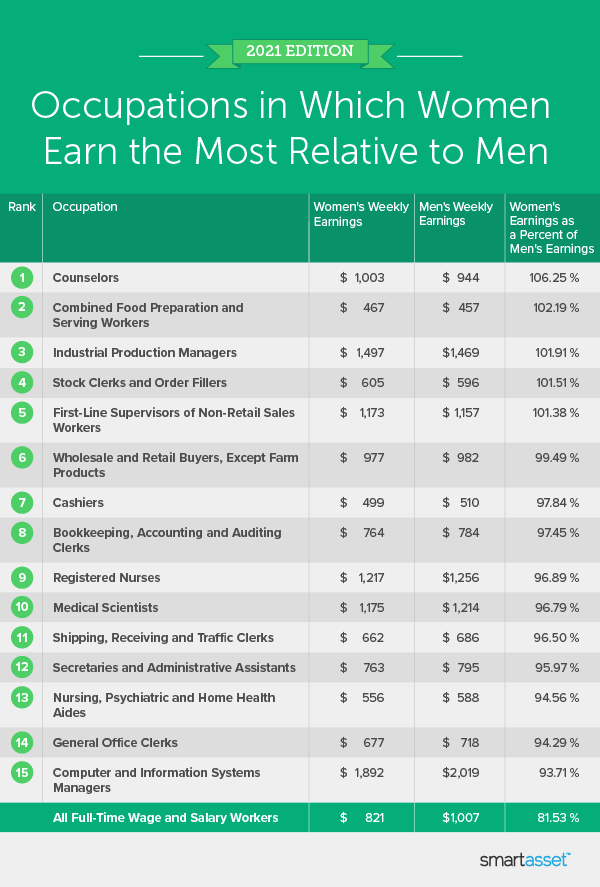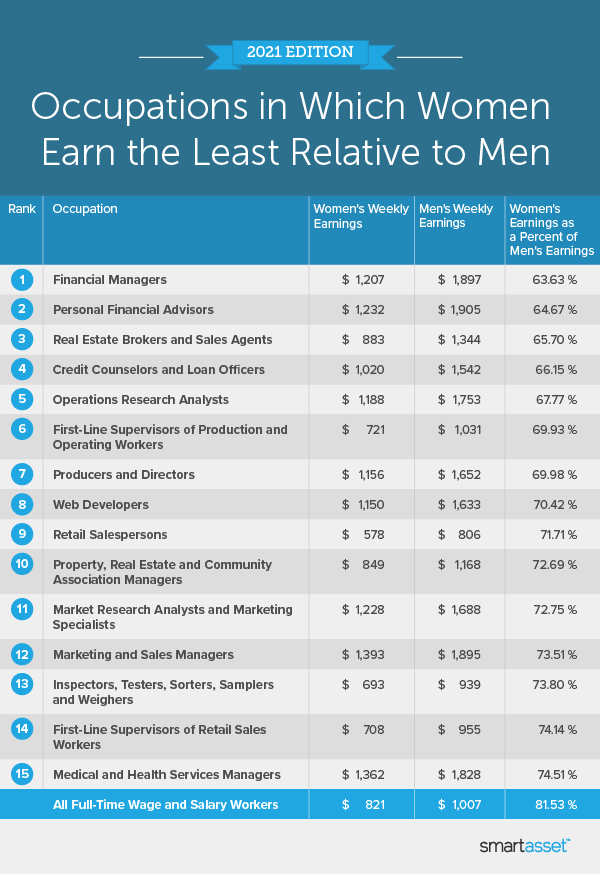Bureau of Labor Statistics (BLS) data from the second quarter of 2021 shows that female, full-time wage and salary workers earn 82% of what their male counterparts do on average. This pay gap has remained relatively constant over the past decade, but it varies even further among women and men when comparing different racial and ethnic demographics. For instance, Black women’s median weekly earnings ($746) make up only about 67% of white men’s median weekly earnings ($1,115). However, median weekly earnings for white and Asian women ($921 and $1,037, respectively) exceed those of Hispanic men ($825).
Just as race and ethnicity affect pay gaps between men and women, occupation also plays a role. In this study, SmartAsset investigated the occupations in which women earn the most and least relative to men. Specifically, we used BLS data from 2019 to compare median weekly earnings for women and men for a total of 111 occupations. For details on our data sources and how we put the information together to create our findings, check out the Data and Methodology section below.
Key Findings
- There are few occupations in which women earn more than men, but the figure is an improvement from previous years. Across the 111 occupations in our study, there are only five occupations in which women’s average weekly earnings exceeded men’s average weekly earnings in 2019. However, this marks progress compared to the previous edition of this study. According to BLS data from 2018, women’s weekly earnings were higher than men’s only for the occupation of wholesale retailers and buyers (except farm products).
- Average weekly earnings for women are highest among chief executives, but there is a large pay gap in this occupation. Female chief executives earn $2,019 per week on average, which is the highest average weekly earnings for women in our study across all 111 occupations. However, male chief executives earn $2,509 per week on average, meaning that the pay gap for this occupation is 80.47% – a full percentage point lower than the national average of 81.5%.
Occupations In Which Women Earn the Most Relative to Men
As previously noted, women earn more than men in five occupations. They include:
- Counselors
- Combined food preparation and service workers
- Industrial production managers
- Stock clerks and order fillers
- First-line supervisors of non-retail sales workers
Across those five occupations, women industrial production managers earn the most on average. According to 2019 BLS data, average weekly earnings for female industrial production managers are $1,497, about 82% higher than average weekly earnings for all female full-time wage and salary workers ($821).
Beyond those occupations, there are seven additional occupations for which the pay gap is less than 5%. In other words, women’s average weekly earnings in these occupations make up at least 95% of men’s average weekly earnings. The table below shows the top 15 occupations in which women earn the most relative to men.

Occupations in Which Women Earn the Least Relative to Men
According to BLS data, there are seven occupations in which women earn less than 70% of what men earn on average. They include:
- Financial managers
- Personal financial advisors
- Real estate brokers and sales agents
- Credit counselors and loan officers
- Operations research analysts
- First-line supervisors of production and operating workers
- Producers and directors
Among those occupations, the occupation of financial managers has the largest percentage and gross difference between women’s and men’s weekly earnings. According to BLS data, female financial managers earn $1,207 per week on average and male financial managers earn an average of $1,897 per week.

Data and Methodology
To find the occupations in which women earn the most and least relative to men, we considered all occupations reported by the BLS. After eliminating occupations with incomplete data or those with “all other” or “miscellaneous” in the title, we were left with a total of 111 occupations. For each of those occupations, we looked at two factors:
- Median weekly earnings for women. This is for full-time women.
- Median weekly earnings for men. This is for full-time men.
Data comes from the Bureau of Labor Statistics and is for 2019.
To rank occupations, we divided median weekly earnings for women by median weekly earnings for men. Occupations in which women earn the most relative to men are those with the highest calculated percentage. Occupations in which women earn the least relative to men are those with the lowest calculated percentage.
Tips For Increasing and Maximizing Your Paycheck
- Ask for a raise. There has been a rising trend of employers giving promotions without a pay raise, according to a recent survey of 300 employers by the staffing firm OfficeTeam. If you are accepting a promotion and taking on more responsibility, be sure you are asking to be compensated fairly. One of the best ways to do this is to see what other people in your occupation are making. The BLS publishes annual employment statistics that show the average hourly and annual wage by occupation.
- Use a bump in your salary wisely. If you get a raise, think about the best way to allocate extra money you are making. Our paycheck calculator can help you calculate the difference in your take-home pay. With that difference in mind, consider adding some of the money to a savings account and take advantage of compound interest. Take a look at our investment calculator to see how your money could grow over time.
- Consider professional help. A financial advisor may help you be better in control of your money. SmartAsset’s free tool matches you with financial advisors in your area in five minutes. If you’re ready to be matched with local advisors that will help you achieve your financial goals, get started now.
Questions about our study? Contact us at press@smartasset.com.
Photo credit: ©iStock.com/whyframestudio
